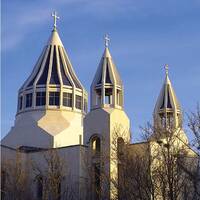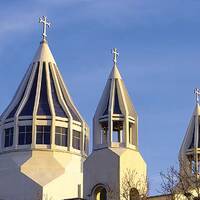The white building of Saint Sarkis Cathedral with a conical dome and raised Minarets is the hangout of Armenians who live in Tehran.
Saint Sarkis Cathedral is one of the main symbols of Armenian presence in the heart of Tehran city. This cathedral was built in 1970 showing a combination of Middle Ages and modern age architectures in the center of Tehran.
The need for building a larger cathedral in the central regions of Tehran was felt in the second half of the twentieth century when the population of Armenians was increasing in Tehran and they couldn’t access to the cathedrals in the southern parts of the city. Therefore, the caliphate of Tehran’s Armenians bought a piece of ground close to one of the Armenian districts of Tehran with the aid of an Armenian benefactor named Markar Sarkissian.
It was in 1343 SH that the cathedral was started to build in the presence of Archbishop of Armenian in Tehran, clerics and a large population of Armenian Iranians. The construction process lasted to 1349 SH and it was officially opened in 1352 SH in the presence of religious authorities and the state authorities of Iran and Armenia.
The building of the caliphate council was also built in the external area of the cathedral. The grave of an archbishop, Artak Manukean, is the only tomb in the courtyard of the cathedral. However, the more interesting part in the courtyard is the memorial monument of Armenian Genocide located in the back of the courtyard showing the tragedy of mass extermination of Armenian by Ottoman empire.
Designed as a three-piece stone, this monument is the symbol of a nation who was killed for their belief. The motif of cross on these stones is the symbol of resurrection of Christ and the martyrdom and movement. It indicates that Armenian society tolerated all killing, displacement, dispersal and several centuries of alien domination and they finally established the independent government of Armenia in 1918. The motifs on this memorial is totally indicating the spirit of freedom, perseverance, adherence to the faith and belief in the final triumph of the truth.
The entrance of the cathedral includes a main larger gate in the middle of two smaller ones in two other sides. A beautiful hall decorated in wall paintings of the Gospel’s stories is seen inside the cathedral. There is also a balcony for choir performances in this hall. Two other entrances are placed posterior to the main one under bell towers.
The internal plan of the cathedral is cross, its external walls are decorated in white marble and internal walls and ceiling are covered with chalk. The alter is also full of painting related to the stories of the holy book. Based upon the tradition of Armenian, the alter is placed in the east and its floor is upper than the ground level of the cathedral.
Today the Iranian Armenians gather here to hold their religious ceremonies. The rituals that have a deep root in the old history and culture of Christianity.


